Here in Zaragoza, Spain, I was fortunate enough to see the Fiestas del Pilar – a huge festival which takes place every year around the 12th October (el día de nuestra Señora del Pilar). There is a myth that St. James the apostle witnessed the Virgin Mary appear on a pillar in Zaragoza and so a huge basilica was built around it, and now every October people from all over Spain travel to offer flowers and fruit to the Virgin Mary and there are a huge variety of events and traditions which make up the Fiestas del Pilar.
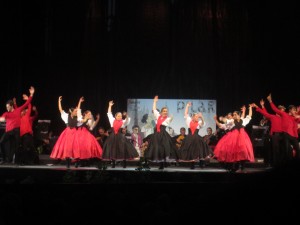
One of these traditions is La Jota, a traditional Aragonese folk dance. As I am studying it for my Year Abroad Research Project (YARP) I had asked people in casual conversation during my first couple of weeks in Zaragoza about the dance, and they all told me I would see lots of Jotas in the festival, and they were right! There were performances every day throughout the festival and I got to see various different Jota groups perform, each with their own style or take on the dance. There were key elements to all the dances such as the raising of the arms, the footwork of heel, toe, heel, toe and lots of jumping and clicking of heels. But there were noticeable differences for example some of the dances used props such as scarves, others included castanets, and there was also a difference in the clothing, some of which was more traditional than others.
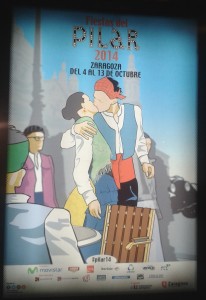
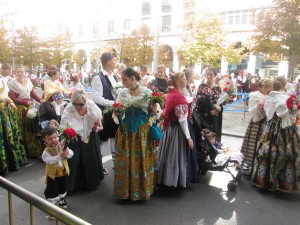
The traditional clothing was beautiful, the women wear long, mostly flowery, dresses with shawls and their hair is always tied in a plaited bun, whilst the men wear shorts and waistcoats with long socks and braces, and headscarves. The people dressed in these outfits are known as baturros/baturras or joteros/joteras. Even the official poster for the festival was of two baturros kissing in the Plaza del Pilar (the main square in Zaragoza). The Jota was a key part of the festival, and on the main day of the festival almost everyone in the city centre came dressed as baturros to the ofrenda de flores. People of all ages dressed in the traditional clothes of the region, most of which have been passed down through generations, and queued up to give their flowers to the Virgen del Pilar which were displayed on a metal pyramid in the main square. At the top of the pyramid was a statue of the Virgin Mary and the flowers were placed beneath her – it was incredible!
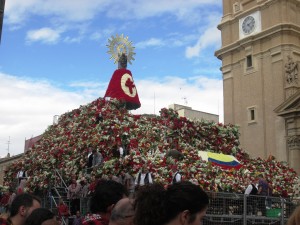
There were many Jota performances happening that day on a stage right in front of the flowers, so it is clearly a very important tradition in Aragón. The music that accompanies the dancing is very unique – you can hear the spanish twang of the guitar, and a lute and mandolin are often played too, and sometimes the brass undertones of the trumpet as well as tambourines or castanets which make a “clac-clackety-clac” sound to add to the layers of the folk music. The Jota is not just a dance, however, there are also Jota singers who are mostly female and sing in a loud (and warbly) voice mostly about the Virgen del Pilar. I have to say the singing was not really my cup of tea, but I loved the dances!
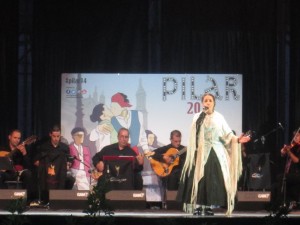
I am very lucky that I got to see so many Jota performances in the festival, not only as now I have a lot of photographs and video footage of the dance for my project, but also because I got to blend in with the crowds watching the dances where most people were taking photos and videos. The next step in my project is to find out what the differences are between the different styles of the dance I have seen. I have found some dance schools in Zaragoza where they teach La Jota, so I am going to enroll soon and hopefully it will help me understand the dance a bit more, not to mention it will open up many doors for me to start the interview part of my project. I also need to head to the local library to research a bit about the history of it all, but for now I have lots of raw material to begin to analyse (and enjoy)!

Dear Sarah,
A very good start to your ethnographic project! Please make sure you organise your material systematically : date of observation, place and a few notes about the observation. You use the term traditional a few times when you describe the costumes, could you expand on why some are more traditional than others? were they describe as such by the participants? Or it is your own interpretation? And what do you mean by that?
It would be great to get in touch with a few of those groups performing and see if you could organise a few interviews and discuss your observations. Please do not forget to fill in the research protocol form it is time now as you start the participant observation and filming etc…
This is a great idea id you could join one of those classes, that could be another way of doing your yarp. At this stage it is about getting a feeling about your object of study, a sense of how it manifests itself then it will be easier to make soem choices about the focus you wish to develop.
Good luck!
Marion.
What a great way to start you YARP! The footage is fascinating and a great visual record for you to work from. It is really good that you have had exposure to such an array of Jota performances so that you already have a sense of dance and the difference ways in which it can be performed. As you say, the next step is to start exploring where these differences come from and what they mean. In addition to contacting the dance schools, have you thought about contacting some of the festival performers? I am not sure how easy this would be to do, but if there is a website or were posters for the festival you can perhaps get some names and start from there.
Claire
These are great photos and reflections, Sarah – you are off to a flying start! I would agree with Claire that it would be good to try to contact some of the groups that were involved in the performances to get some insights into the differences between the types of Jota that you saw. Were they all specifically dance troupes, or did they represent local cultural associations or other types of organisations? Local histories will also be a good place to look to read more about the evolution and local meanings of the dance.
You mention ‘tradition’, ‘traditional dress’, etc. – your research will want to unpack these ideas a bit more by investigating how the Jota has been developed, used, and re-purposed in new contexts. The classic academic work on this is Hobsbawm’s The Invention of Tradition, which looks at how things we think of as traditions are often of quite recent invention. Marion has also suggested to another student recent articles on the reinvention of European rituals in the Journal of the Royal Anthropological Society, and a book called Revitalizing European Rituals by Boissevain (1992). These might be useful as you start to delve a bit more into the different styles and purposes of the dance.
Good luck with the classes as well – sounds like fun!